|
Photos: Ann Hazard
Baja is the world's longest
peninsula and the last outback left
in our corner of the world. It's a
place where my children have run
free since they were little --- able
to hike, kayak, swim, snorkel, ride
horses, explore beaches, tide pools
and bargain for goodies in the local
shops. I've been hanging out in
Baja since I was little, as has my
father and his before him. I've
always felt more at home south of the border. I love the
endless empty hills, sunny skies and see-through turquoise
water. I love the food, the foot-stomping music, the fiestas, and
of course the Mexican people with their easy-going, friendly,
everybody-helps-everybody-else attitude.
When I cross the border and drive south along the edge of
the Pacific, my senses open up and I'm tickled by a hunger for
adventure and a taste of wildness. The further south I go, the
more I'm reminded that I'm a very privileged guest in this
world. Things in Baja are still so much the same as they've
always been --- untouched, untainted and untamed. This is truly
a place where man's creations are dwarfed by God's. This is
truly a place that warrants preserving. Here are a few reasons
why:
1. BAJA'S GRAY WHALE NURSERIES
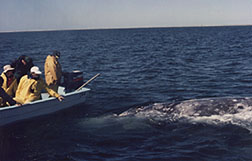 |
Baja is where the Pacific Gray Whales come each year
to mate and give birth. All 26,000 of them make an annual 10- to 12,000-mile round trip from their feeding grounds in the Arctic to the
protected lagoons of Baja California Sur (including Laguna Ojo de Liebre and Laguna San
Ignacio and Bahia Magdalena). |
Some of the most playful and
prolific of all cetaceans, their population has rebounded from a
scant 500 in 1947 when they were put on the Endangered
Species List, to what's assumed to be their original number. So
remarkable has been their recovery, that they were removed
from protective status in 1994. A national and historical
treasure, they may only be visited when accompanied by an
official guide.
 |
2. BAJA'S CAVE PAINTINGS
Baja is home to over 100 (thus far
discovered) majestic, prehistoric cave
paintings. These amazing works of art
showcase multi-layered, floor-to-ceiling red
and black monos (human figures), birds,
rabbits, deer, big-horned sheep, turtles,
fish, sea mammals, and other creatures that
shared the mountains and coastal waters with
them. A national and historical treasure, they may only be
visited when accompanied by an official guide. |
3. BAJA'S MISSIONS
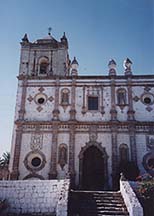 |
Birthplace of the Californias: Baja is rich in
history from the Missionary Era, which began in the early 1500's and
ended 300 years later when all the missions were secularized by the Mexican government. While Cortez, Ulloa, Vizcaino and Cabrillo all explored the Magnificent Peninsula, it wasn't until Father Juan Maria Salvatierra, a Jesuit priest landed in Loreto in 1697 that a permanent settlement was established in Baja. The Jesuits built a total of 18 missions from 1697 - 1767 when the Franciscans, under Father Junipero
Serra, took over. |
He established only one mission in Baja
before moving north to San Diego and Alta California. The
Franciscans ceded the Baja missions to the Dominicans in 1773
and in the next six decades, the Dominicans built nine more
missions in Baja. By then, however, the population of native
Indians had shrunk (due to death by warfare and disease) to
only a fraction of its original number, so there was no longer an
economically feasible reason for the existence of the missions.
By 1846 the era of the missions was over, but all 28 remain and
many house active parishes today.
4. BAJA'S OCEANS
Baja California exists on over 2000 miles of coastline --- not counting any of the zigs and zags. Off the west coast of both are the cool waters (55� - 70� Fahrenheit) of the Pacific. This ocean offers up lobster, abalone, tuna and halibut --- to name only a few varieties of its bounty. The much warmer (usually 75� - 85� Fahrenheit) Sea of Cortez is a 1000 mile ocean trench that extends between Baja on the west and the Sierra de la Madre Mountains of mainland Mexico on the east. It's
home to at least 850 known species of marine creatures, (the richest abundance of undersea life anywhere on the planet) ranging from shrimp to dorado to huachinango to tiburon to the magnificent marlin and sailfish.
5. BAJA'S SPORTFISHING
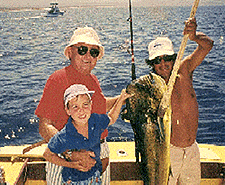 |
Some of the best big game fishing in the world is found just north of Cabo San Lucas off the east coast of southernmost Baja. I know --- my dad began taking us there when I was eight. Back in the early '60s when we first visited La Paz and the East Cape area just to the south of it,
the only way to get in was by boat or by air. The paved road wasn't completed for another decade. |
Our good friend, pilot Francisco Munoz, flew there regularly, carrying his share of rich and famous Baja Aficionados down there to fish. Guys like Chuck Connors, Desi Arnaz, Fred Astaire, Ray Cannon and my
grandpappy's pal, Erle Stanley Gardner. Back then the waters
churned with rooster fish, the wildest fighters in all of the Sea
of Cortez --- said to be even more exciting to reel in than a
marlin. The Mexican government is dedicated to preventing this
rich sea from being fished dry. Much has been done to eliminate the devastation caused by gill net fishing. A program called �Sueltame! which means "Release Me!" has made it fashionable for fishermen and women to release their big game fish rather than have them stuffed to take home as trophies.
6. BAJA'S DIVING AND SNORKELING
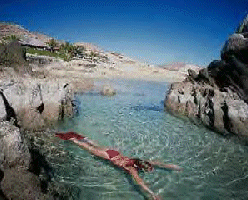 |
The Mexican government has also designated an area off Cabo Pulmo on the East Cape as an underwater national park. Fishing is not permitted. Only divers and snorkelers are welcome in this 10 mile long by three mile wide park covering a coral reef that forms green and rust-colored coral
outcroppings that look like huge heads of cauliflower. |
In between coral and waving meadows of seaweed swim needlefish,
angelfish, navy blue damselfish, tiny polka-dotted, spiny
blowfish, pale turquoise, lavender, green and pink parrotfish,
silvery triggerfish, poisonous pufferfish, moray eels, countless
tiny darting flourescent fish and the occasional game fish.
Snorkeling and diving is great in many spots on the Sea of
Cortez and in La Bufadora in northwestern Baja.
7. BAJA'S SECRET SURF SPOTS
Surfers' names for their favorite breaks don't show up on any maps ---
probably because they like to keep them a secret from all but the truly dedicated and duly initiated. There are numerous "killer" breaks on the
Pacific coast of Baja, from the border to Todos Santos. There's even a surf beach in San Jose del Cabo. Baja surf spots are in a league of their own....
8. BAJA'S MOUNTAINOUS CENTRAL DESERT
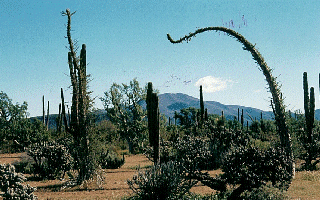 |
Just southeast of El Rosario, Mex 1 snakes its way up to Baja's Central Desert and the famous boulder fields of Catavina. Over 100 species of cacti grow here, 80 of which grow nowhere else on earth. |
The majestic cardon are related to the saguaro we have in Arizona. The difference is that cardons have multiple trunks. They have
strong hardwood skeletons that are used around here as building material on the ranchos. When it rains, they become rotund and succulent. They get as tall as a six-story building and can weigh up to 12 tons. Cirios, or boojum trees, live nowhere else on Earth, except here and in Sonora, across the Sea of Cortez is proof positive that the peninsula was
connected to the mainland at one time in the distant geologic past.
Cirios look like dancing creatures from another galaxy. They have chunky bases that thin rapidly to one or more gangly branches --- long ones that wave about like arms and shorter ones that wiggle on tapered ends, like fingers. On top of their heads grow a crown of yellow flowers that look like pompadours. The stark, alien landscape is also home to ocotillos, chollas and that gnarly old-man, the elephant tree.
9. BAJA'S GOLD COAST
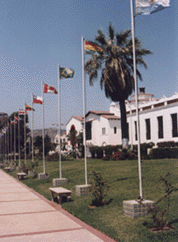 |
Northern Baja, from the Tijuana border to Ensenada is known as the "Gold Coast," is home to thousands of American retirees
and weekend fugitives from Southern California. It's also the most-visited area of Baja. Aside from driving the toll road to Ensenada (don't forget your Mexican car insurance!), visitors
can take three to four day cruises to Ensenada from L.A. and San Diego. Shopping, dining, dancing, horseback riding and ATV riding on the beach or just getting away from it all. More people visit this part of Baja than any other because of its accessibility. It works for me when I need a Baja fix --- which is frequently! |
10. BAJA'S TROPICAL DESTINATIONS
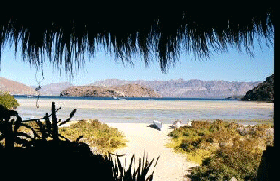 |
Tourists can fly into Loreto, La Paz and Los Cabos in Baja Sur on commercial jetliners. The towns of Cabo San Lucas and
San Jose del Cabo and the corridor in between comprise one of
the west's most visited tropical resort areas. |
La Paz is an elegant, sexy, seafront Mexican city that doesn't
cater much to tourists. People looking for a resort-type
vacation more authentically Mexican than Cabo would be
well-advised to spend time in La Paz. World class fishing,
diving, dining and nightlife abound here. Carnaval, Mexico's
answer to Mardi Gras is a great time to visit.
Todos Santos, a beautifully
restored Mexican colonial town and
artists' colony with great
restaurants and some of the hottest
surf spots on the coast. It's located
on the Pacific Ocean, about midway
between Cabo San Lucas and La Paz.
Behind its sleepy facade, there's a
lot going on here. Stop in and stay a
few days. Or months....
Mulege is a sleepy town, nestled in palm groves along the only
navigable river in Baja. Six hundred miles south of the border
and 89 miles north of Loreto, it's located two thirds of the way
down the peninsula and marks the entrance to the incomparably
beautiful ...
Bahia Concepcion. The shores of this bay are lined with small coves --- each of which houses yet another camp ground. It's all a camper's,
boater's, windsurfer's and diver's paradise. There's not much better than packing a picnic lunch in a cooler on the back of a kayak and
heading out to snorkel or fish in the clear, warm, light turquoise
waters of the bay, followed by a dip in a natural hot spring....
Loreto is beautiful. Loreto is laid back and fun. Loreto is great
for fishing too. It tried to become a big resort for awhile, but
managed to avert that and stay true to itself. It is, however,
home to an Eden Resort with a world-class golf course.
San Felipe, Puertecitos and Bahia Gonzaga. Bahia Los Angeles.
Puerto Escondido ... just to name a few. There are more places
off the beaten track in Baja than I could ever list here. Do a
little research. Your next dream vacation is around the corner
--- especially if you're a peace and quiet, back-to-nature,
warm weather, warm water, sunrise and sunset Baja-loving
junkie like me!
Ann Hazard
Award winning writer Ann Hazard Ann is a third generation Baja Aficionada who has followed her father's and grandfather's footsteps up
and down the world's longest peninsula since she was nine. She has written two outstanding books on Baja/Mexico - Cooking With Baja Magic and Cartwheels in the Sand. She has also lectured on Baja and cooking throughout California and Baja.
|